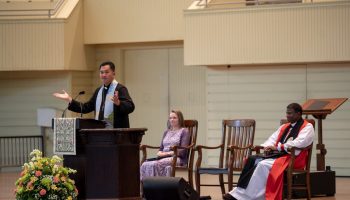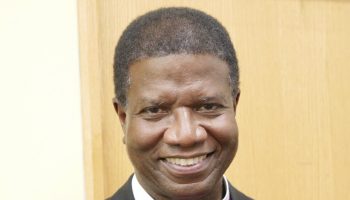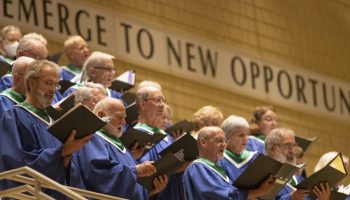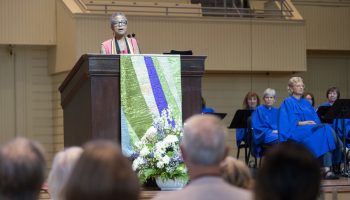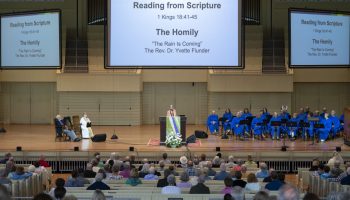
“There is a story that the rabbis tell,” said Rabbi Sharon Brous, “about a group of travelers who go out to sea in a boat. One of the travelers took out a drill and began to drill a hole beneath his seat. The other travelers were alarmed and protested that he would destroy them all. He answered them, ‘why are you worried? It is only under my seat.’ ”
Anti-Semitism in America is at a critial point, she said, and “we are all in this together.”
Brous’ title for her sermon was “Royal Pains: Eternal Outsider, On the Inside,” and her text was Esther 3:2-6.
Brous was in the 14th year of her rabbinate when she gave her first sermon about anti-Semitism. She said she always felt that there were bigger problems to be addressed — racism, poverty, climate change. As relatively comfortable Jews in this kind of world, she did not want to draw attention to anti-Semitism.
“The reality is that anti-Semitism is a dangerous new challenge, and the way we address it as a country matters profoundly,” she said.
She said that anti-Semitism is age-old and has existed across time and place. It is a conspiracy theory rooted in the charge that Jews are responsible for the death of Jesus. It was most pernicious across Europe as it led to “massacres, pogroms, inquisitions and finally gas chambers.” Fueled by church and state alike, it was insidious and ever present in Europe.
While ever-present in America, “there was not the same existential risk,” Brous said. “Even the cold embrace of America was more welcoming than overseas.” She cited housing covenants and the general exclusion from social, economic and political life of America as examples.
“Don’t forget that the S.S. St. Louis was sent back to Europe with 1,000 Jews on board,” she said. “I felt confusion and shame that two of the three country clubs in my county in New Jersey had ‘no Jews, no blacks’ policies.”
It was the lynching of Leo Frank, a factory superindent, wrongly convicted in 1913 of murdering Mary Phagan, a 13-year-old girl who worked in the factory, that increased Jewish sensitivity to the racialized terror of the black community, she said. That racialized terror led to the Great Migration of African Americans to northern cities.
“These stories are only now being told to the mainstream community, by Bryan Stevenson through the Equal Justice Initiative and The National Memorial for Peace and Justice, or Nikole Hannah-Jones,” Brous said.
She noted that Jews joke about keeping their passports up to date, and that it is pretty safe and comfortable to be a Jew in America.
“There are Jews on the Supreme Court, in the Senate and the mayors of the three largest cities are Jews,” she said. “When I went to a Hanukkah party at the White House, I cried when I saw West Point cadets wearing yarmulkes.”
But, she said, in the past three years a new reality has emerged — a real and present danger.
“The synagogue shootings, vandalism and hate crimes reflect a new and terrifying reality,” Brous said.
The conspiracy theory of anti-Semitism posits that the Jewish family is the most dangerous to the human community as a whole.
“This is not like other forms of racism.” she said. “Jews are accused of controlling the banks, the media; are cheap, nationalist and globalist.”
Like most stereotypes, there is some truth, but it is also racist, Brous said.
“Jews are welcomed until a scapegoat is needed. And our oppression is cyclical,” she said. “Why do people with power and privilege feel vulnerable? Because the downfall comes immediately and suddenly, and no amount of money or access or beautiful art can save us.”
This new anti-Semitism has moved from the margins to the mainstream, she said. Violent white nationalists, who feel broken, blame Jews for all their problems and believe that by killing Jews their problems will be solved.
“After the synagogue shootings, these men were called lone wolves, but they are part of a network of heavily armed white men, a network designed to drive a wedge between allies in societies rooted in liberty,” Brous said.
Eric Ward, author of Skin in the Game: How Antisemitism Animates White Nationalism, wrote that white nationalism is built on racial superiority and white nationalists would like an all-white nation, but anti-Semitism fuels white nationalism. It is modeled after Nazi Germany, and white nationalists want to “eradicate all Jews, blacks, other people of color and all their associates.”
The last three years have been “banner years for them because they have been so openly embraced by the political mainstream.” Brous said. “They are a threat to Jews, Muslims, blacks, LGBTQ people and their allies, as they undermine democracy and our social fabric.”
Brous told the congregation, “we are all in this together. If one of us drills a hole, we will all drown. We must address this with the urgency it requires.”
Brous believes that in times of trouble, our traditions and texts can be helpful to find a way out of trouble. After the Babylonian exile, there were still Jews living in Persia, and King Ahasuerus sat on the throne in the city of Susa.
One night the king ordered his wife, Vashti, to dance naked before his courtiers.
“He was obsessed with his wealth, his golden palace and was a womanizer and a buffoon,” Brous said. The congregation laughed.
Looking for a new wife, he found Esther, an orphaned Jewish woman raised by her cousin Mordecai, an assimilated Jew and a judge. The viceroy, Haman, induced the king to order that all people should bow down and do obeisance to him — and Mordecai refused.
Haman was so enraged he decided to kill not only Mordecai but all the Jews of Persia, and he asked the king for permission to kill the Jews. The Jews employed spiritual power and their political connections in the place, through Esther, to defend themselves and survive.
What is pernicious about this story, Brous said, is that first Mordecai insulted Haman, but Haman was so outraged that he quickly extended his anger to all Jews.
“This reveals an eternal truth that any representative of a minority is held accountable for the acts of all, which is at the heart of many forms of racism,” she said.
As one man’s anger led to a plot to kill all the Jews, the king showed a “subterranean racism against the Jews,” she said. “He was delighted that Haman would kill them for him. It is only when the two hatreds meet — overt plus subterranean — that racism erupts.”
“I am asking you today for help,” Brous said. “Join me and my community and defend against anti-Semitism that comes from the right or the left. We tend to forgive small comments when they come from allies, but the virus festers and we have to stop it. They mask the real threat of violence.”
She urged the congregation, “don’t play down white nationalism. Anti-Semitism endangers Jews, all of us and the democratic order. It drives wedges between allies and destroyed European Jews and the European idea.”
Not everyone is our enemy, she reminded the congregation.
“Many people hold us in love and will stand with us,” she said. “The best antidote is to join forces, in the fervor of love, with those who are marginalized. We really are all in this together.”
The congregation responded with a standing ovation and the Rev. George Wirth called the congregation to a moment of silence and contemplation.
The Rev. George Wirth presided. Mark Altschuler, who oversees the men’s softball league at Chautauqua and is a professor of English at Bergen Community College in North Jersey, read the scriptures. Barbara Hois, flute, and Joseph Musser, piano, played Sonata No. 9 for Flute and Piano, by Frederick the Great as the morning prelude. The Motet Choir sang “Lord, Afford a Spring to Me,” by Stewart Duncan under the direction of Jared Jacobsen, organist and coordinator of worship and sacred music. The Edmund E. Robb – Walter C. Shaw Fund provides support for this week’s services.

